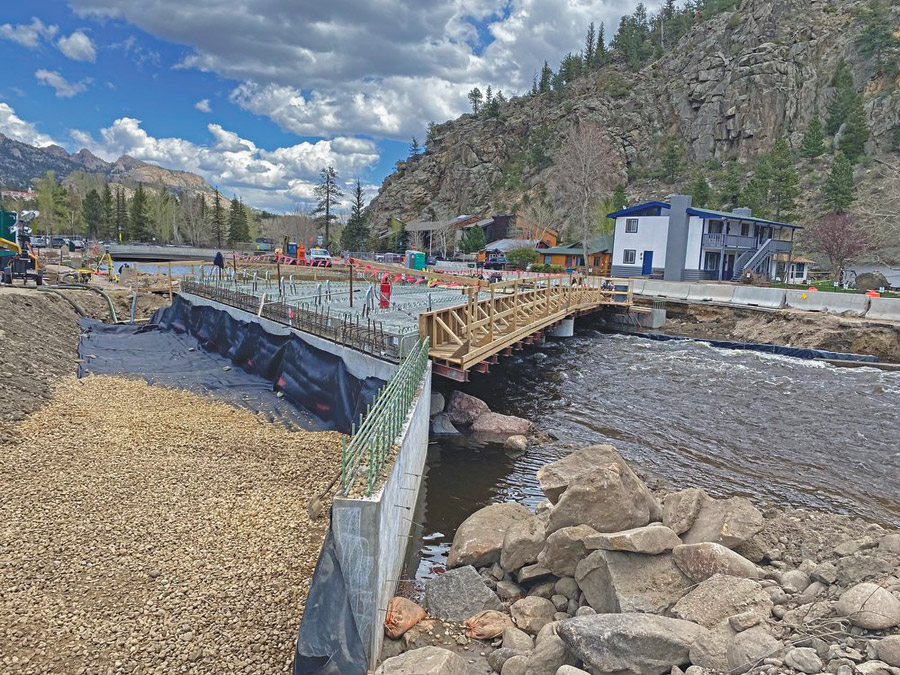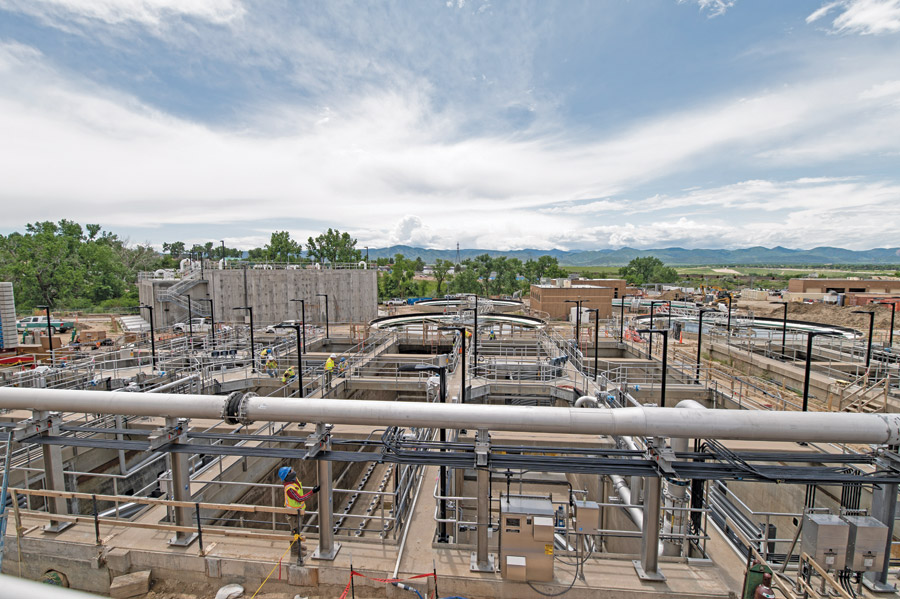Numbers alone say a great deal about the past year’s performance for Flatiron Construction, ENR Mountain State’s Contractor of the Year for Colorado, Wyoming and the Dakotas. The company’s Broomfield, Colo.-based regional operation reported a 30% increase in revenue, to $184 million, with a variety of major infrastructure projects that contributed to a No. 22 regional ranking and a No. 9 ranking nationally among domestic heavy contractors and in the transportation sector.
Flatiron’s seven Colorado offices provided the reach to serve every part of the state and beyond during 2022. The company continued its long-standing relationship with Denver International Airport (DIA) via concourse and airside projects that will boost the critical air hub’s capacity by 30%. Other major work for the year includes collaborating with the Colorado Dept. of Transportation to implement capacity and safety improvements at I-25 Exit 11 near Trinidad; assisting Berthoud-based Northern Water to restore an area devastated by the 2020 East Troublesome Fire; and upgrading the nearly 40-year-old Marcy Gulch Wastewater Treatment Plant for the Centennial Water and Sanitation District.
But numbers and an active slate of projects tell only part of Flatiron’s story. According to Grant Johns, vice president in charge of Flatiron’s Colorado operations, years of focusing on the basics—retaining good employees and cultivating repeat business—have positioned the firm not only for new opportunities but also for a shift in the way those projects are being delivered.
“As the market moves toward collaborative delivery, it’s so important to have the qualifications and good project track record to compete successfully for that work.”
—Grant Johns, Vice President, Flatiron
“As the market moves toward collaborative delivery, it’s so important to have the qualifications and good project track record to compete successfully for that work,” Johns says.
Dale Nelson, Flatiron’s executive vice president for operations, adds that being part of a larger organization enables the seven Colorado offices to adapt to almost any type of client or assignment. “In this market, that’s the key to success,” Nelson says. “You’ve got to have that versatility—be able to move around and maintain relationships with big clients and small clients alike.”
Northern Water project manager Landon Shaw says those attributes were valuable throughout the two-year East Troublesome Fire restoration effort, which wrapped up in June. Using a construction manager/general contractor delivery, Flatiron handled a variety of assignments designed to restore the environmental resilience of parts of the nearly 193,000 acres burned in the second-largest fire in state history. Work included debris removal and the construction of flood-reduction structures to reduce flood risks to affected properties as the land gradually recovers.
“The CM/GC contract helped Flatiron get involved early with the design teams to prepare projects and plan for challenging conditions,” Shaw says of his agency’s first project with the company. He adds that the area, though devastated by fire, remained highly dynamic, requiring the quick clearing of major storm-driven debris slides two summers in a row.
“Flatiron responded quickly and kept the overall project going,” Shaw says. “Without the CM/GC approach, we would not have been as successful.”

A new bridge across the Big Thompson River is part of the Estes Park Downtown Loop project, which will improve access to and from Rocky Mountain National Park.
Image courtesy Flatiron Construction
Air and Spaces
DIA, the world’s third-busiest airport, illustrates the variety of skills and resources Flatiron can bring to a project. Currently, the company is partnering with Turner Construction to expand the A West and B West concourses, including a new 14-gate, 120,000-sq-ft ground loading facility for Frontier Airlines. Along with a complex phasing strategy to prevent interference with airside safety and operations, the concourse projects have involved tackling a full gamut of challenges, from deep foundations and unexpected groundwater to ensuring gate availability for hundreds of flights each day.
“Sometimes we’re doing our work in one postage stamp-size space at a time,” Johns says of the constrained conditions. “It’s taken all our expertise and everybody’s various years of experience to bring that project together and to not only meet but also exceed schedule expectations.”
Jim Starling, the airport’s executive vice president and chief construction and infrastructure officer, explains that as the airport invests in capital improvements to accommodate up to 100 million passengers annually over the next five to eight years, Flatiron has proven to be a trusted partner in executing a wide range of complex projects.
“We have a lot of work going on, and they have stepped up to do what’s needed,” Starling says, citing Flatiron’s recently completed rehabilitation of runway 16R/34L, which, at 18,000 ft, is the longest commercial runway in the U.S.

The I-76 York to Dahlia Road Reconstruction Project north of Denver replaced two narrow, aging bridges over York Street with a single, more resilient structure better suited to modern traffic demands.
Image courtesy Flatiron Construction
“Obviously it was important to us, our airline partners and the [Federal Aviation Administration] to have that runway available,” Starling says. “Now they’re working on a new taxiway that may sound small but is a very important to our airfield capacity and safety.”
The airport also provides a showcase for Flatiron’s embrace of emerging construction-phase technology, including laser scanning, BIM and virtual design and construction tools to review tolerances and resolve constructibility issues well before they reach the field.
In addition, Flatiron has vastly expanded its use of drone technology for site progress monitoring, quantity tracking, environmental inspections and other applications. As part of its work for CDOT’s I-76 York to Dahlia Reconstruction program in Adams County, Flatiron used drone-captured aerial photography to improve the process of planning the replacement of two nearly 60-year-old mainline bridges with a single structure that has improved pavement and a glare-reducing barrier to improve safety.
Alicia Lopez, Flatiron vice president for design management and innovation, says an internal Ideation Campaign has been instrumental for identifying the most promising tools to enhance company processes and procedures.
“We get some very good ideas from our employees, which helps us narrow the range of options,” Lopez says. “We can then evaluate each technology’s potential applications by working with developers and manufacturers on pilot programs and other ways to test their capabilities before implanting them on a larger scale.”

For the Centennial Water and Sanitation District, Flatiron is rehabilitating liquid stream operations at the 40-year-old Marcy Gulch Wastewater Treatment Plant, bringing the facility up to current federal standards.
Image courtesy Flatiron Construction
Coping with Resource Constraints
As with most other contractors in the region, Flatiron has had to apply a fair degree of creativity to navigate material cost and procurement challenges, which, though less intense than in the immediate aftermath of the pandemic, nevertheless continue to overshadow nearly every type of project.
“At the job level, it’s a matter of getting on top of procurement right out of the gate and not letting any dust settle in the meantime,” Nelson says. “We also stay alert for opportunities to rephase work, especially if there’s a risk of long delays.”
Flatiron has also been proactive in its approach to developing a larger pool of craft labor and providing competitive benefits and training to attract top talent. Smaller projects that are hardly routine, such as the new Downtown Estes Loop being built for the Federal Lands Highway Division and the town of Estes Park, provide new hires with valuable experience, Nelson notes. Scheduled for completion next year, the project combines safety and traffic flow upgrades in the popular mountain town along with river improvements that will create a better habitat for fish.
“At the job level, it’s a matter of getting on top of procurement right out of the gate and not letting any dust settle in the meantime.”
—Dale Nelson, EVP Operations, Flatiron
Johns says a similar approach is helping Flatiron cultivate Colorado’s small and disadvantaged business community. “We not only embrace client goals for participation, we try to beat them,” he says. “For example, we’ll look for ways to divide project scope elements to include smaller sections of work for smaller companies or assign them work that we don’t have to self-perform to meet a critical path need.”
As a participant in the City and County of Denver’s Citywide Mentor/Protégé Program, Flatiron has helped Ram-Co Trucking Services of Fort Lupton grow both its revenue and ability to reach new customers.
“Small companies like Ram-Co are a very important part of our business,” Johns says. “We couldn’t build what we build without them.”
Javier Sevilla, Flatiron president and COO, says ready access to resources will be essential in the coming years as the company seeks to maintain its diverse project portfolio while also pursuing anticipated opportunities with DIA and CDOT, particularly with the anticipated jump in projects funded by the Infrastructure Investment and Jobs Act entering the pipeline.
“This is a great time for the industry,” Sevilla says. “We see the funds coming along with the right kind of collaborative contracts that provide the upfront investment, allowing us to get involved early, fully understand project issues and enable clients to be part of the solution before you start construction.”




Post a comment to this article
Report Abusive Comment